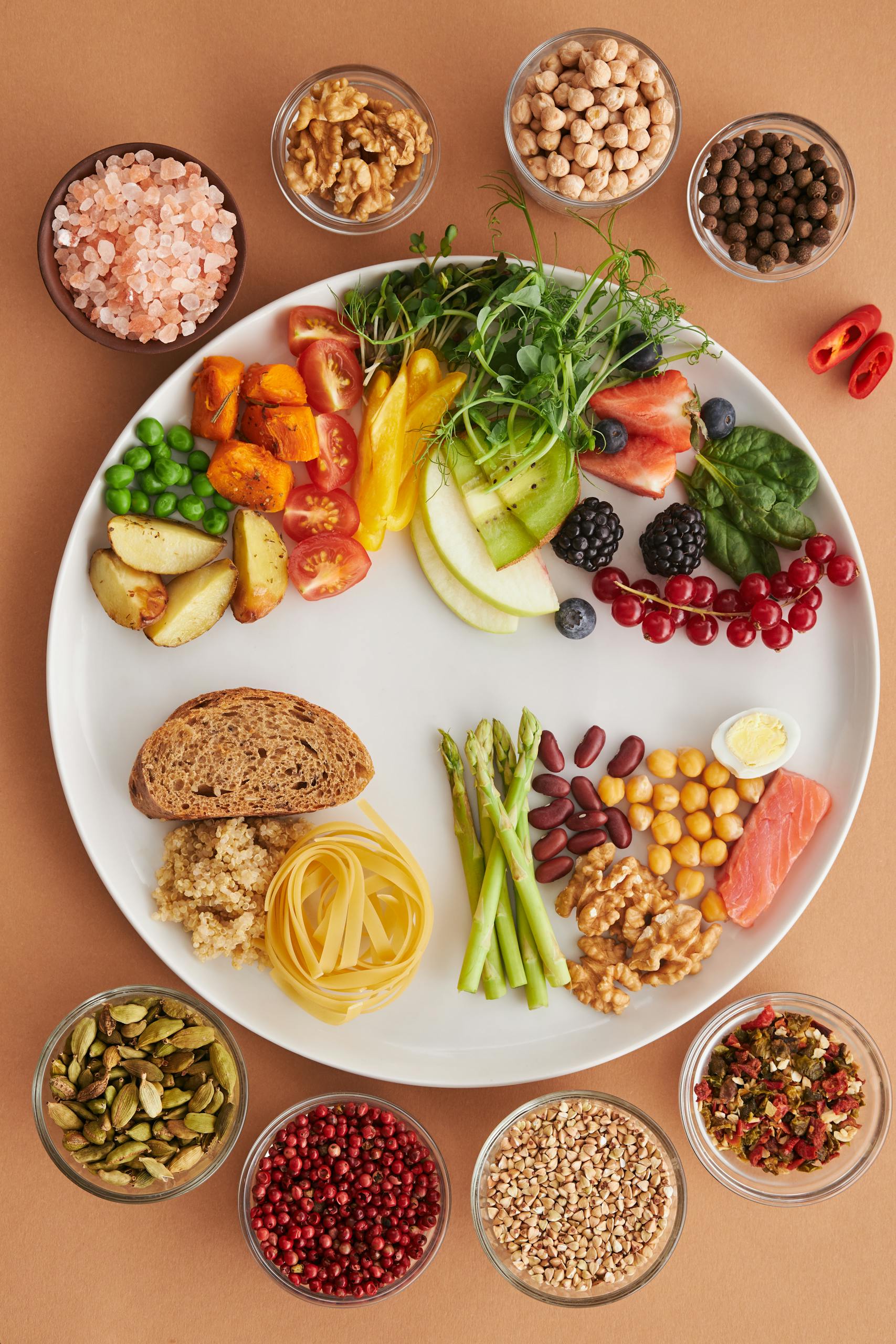
In recent years, a hormone called glucagon-like peptide-1 (GLP-1) has taken center stage in the conversation about metabolic health. You may have heard of medications like Ozempic or Wegovy that work by mimicking this hormone, helping people regulate blood sugar, appetite, and weight. But what if you could naturally support your body’s GLP-1 production through simple, sustainable lifestyle changes? Let’s explore why GLP-1 is important, especially for women navigating the challenges of perimenopause and menopause, and how to harness its benefits naturally.
What is GLP-1 and Why Does It Matter?
GLP-1 is a hormone naturally produced in the lining of the human digestive tract. It responds to food intake by slowing down how quickly food leaves your stomach, triggering other hormones like insulin and leptin (aka the satiety hormone), and sending “I’m full” messages to your brain. This process helps regulate blood sugar, enhances satiety, and reduces food-related thoughts or cravings. Together, these actions contribute to weight management and overall metabolic balance.
Modern lifestyle and environmental factors mean that most of us will experience some degree of reduced GLP-1 production or responsiveness. An imbalanced diet dominated by ultraprocessed foods, which now account for 70% of the food supply, lacks the nutrients and signals the body needs for optimal metabolic function. Combined with disruptions to the gut microbiome, inflammation, environmental toxins, and circadian rhythm imbalances, these factors strain your body’s ability to regulate GLP-1 effectively. For women in perimenopause and menopause, the role of GLP-1 becomes even more critical. Hormonal shifts during this life stage can impact digestion, leading to blood sugar fluctuations, increased appetite, and stubborn weight gain. Optimizing GLP-1 levels helps to combat these changes by promoting metabolic resilience and steady energy levels.
When GLP-1 production or responsiveness falls short, medications like Ozempic can offer therapeutic support, ranging from short-term to ongoing use. By working in place of your body’s own GLP-1, they help regulate blood sugar, manage appetite, and support metabolic function. However, prioritizing lifestyle strategies to boost GLP-1 production is essential to sustainable, long-term health. Improving your body’s GLP-1 activity not only reduces reliance on medications but also aligns with your body’s natural rhythms. This is especially crucial during perimenopause and menopause, when hormonal shifts make maintaining metabolic balance more challenging.
The “Ozempic/GLP-1 Era” and Its Implications
Medications like Ozempic have brought GLP-1 into the spotlight, offering therapeutic benefits for weight loss and blood sugar regulation. While effective, they come with potential drawbacks, including side effects like nausea, constipation, and the risk of losing lean body mass—an especially important consideration for women in perimenopause and menopause. Additionally, these medications don’t address root causes like poor diet, stress, insufficient sleep, and inactivity, which are critical for long-term health.
This is where lifestyle strategies shine. By optimizing GLP-1 naturally through targeted nutrition, movement, and stress management, you can achieve sustainable results while reducing reliance on medications. Healthcare practitioners and registered dietitians play a crucial role in tailoring plans to meet your unique needs, whether that involves medication, lifestyle changes, or a combination of both. Together, these approaches create a pathway to lasting metabolic health and resilience.
Enhancing GLP-1 Naturally
1. Power Up with Food Choices
Certain foods can stimulate your body’s natural production of GLP-1, making diet a powerful tool for metabolic health.
- Fiber-Rich Foods: Soluble fiber found in oats, flaxseeds, and legumes nourishes gut bacteria, promoting GLP-1 release. Try plain Greek yogurt or cottage cheese with raspberries and a sprinkle of flaxseeds for a high-protein, fiber-packed breakfast or enjoy a hearty chicken salad with mixed greens, chickpeas, and olive oil dressing for lunch.
- Probiotic-Rich Foods: Fermented foods like yogurt, kimchi, and sauerkraut support a healthy gut microbiome, which plays a crucial role in GLP-1 production.
- Polyphenol-Rich Foods: Foods like berries, dark chocolate, and olive oil contain antioxidants that help reduce inflammation in the body, improve gut microbiome diversity, and enhance GLP-1 activity.
- Bitter Greens: Leafy greens like arugula, kale, and collard greens contain compounds that activate GLP-1 receptors. Add them to salads, sauté them as a side dish, or blend them into smoothies for an easy nutrient boost.
- Protein-Rich Foods: Protein plays a crucial role in boosting GLP-1 production. Foods like eggs, lean meats, fish, tofu, and legumes provide the amino acids necessary for hormone synthesis and signaling. Including a source of protein in each meal helps maintain steady GLP-1 levels while supporting muscle preservation and satiety.
- Healthy Fats: Healthy fats, such as those found in avocados, nuts, seeds, and olive oil, are essential for GLP-1 support. These fats slow digestion, providing a steady release of nutrients, and promote satiety, helping to regulate appetite and blood sugar levels effectively.
2. Move Your Body
Regular physical activity can boost your GLP-1 levels. Aim for a combination of cardio and strength training to optimize metabolic health. A brisk walk, yoga session, or strength workout not only supports GLP-1 but also helps reduce stress, a common disruptor of hormone balance.
3. Prioritize Gut Health
Your gut lining is where GLP-1 is produced, so maintaining a healthy digestive system is critical. Avoid highly processed foods that can disrupt your microbiome and focus on whole, nutrient-dense options. Prebiotic foods like bananas, onions, and garlic feed beneficial gut bacteria, while probiotics add good bacteria to your system.
4. Manage Stress
Chronic stress can interfere with your hormone balance, including GLP-1 production. Incorporate stress-reducing practices like meditation, deep breathing, or journaling into your daily routine. Even taking five minutes to pause and breathe deeply can make a difference.
5. Get Quality Sleep
Sleep is a cornerstone of hormone health. Aim for 7-9 hours of quality sleep each night to support optimal GLP-1 levels. Create a calming bedtime routine, limit screen time before bed, and maintain a consistent sleep schedule.
6. Stay Hydrated
Proper hydration is essential for maintaining overall metabolic health and supporting GLP-1 function. Water aids in digestion, nutrient absorption, and maintaining a healthy gut lining. Additionally, ensuring an optimal intake of electrolyte minerals, such as sodium, potassium, and magnesium, supports hydration at the cellular level and contributes to better metabolic and hormone function. Aim to drink sufficient water throughout the day, and consider hydrating foods like cucumbers, watermelon, and oranges to help meet your fluid and electrolyte needs.
The Role of Supplements
While food and lifestyle are the foundation of GLP-1 optimization, supplements can provide additional support when needed. Look for high-quality, third-party-tested options. Ingredients like yerba mate, curcumin, and berberine have shown promise in supporting GLP-1 activity. Bitter hops has also been used to formulate a natural supplement alternative to GLP-1 receptor agonists, known as Amaraste, which may provide additional support for hormone regulation. However, beware of products claiming to be “natural Ozempic alternatives,” as these often lack scientific backing.
Always consult with a healthcare professional or registered dietitian before adding supplements to your routine, especially if you’re managing existing health conditions or medications.
Conclusion
Optimizing GLP-1 levels is not a one-size-fits-all process. Everyone’s body is unique, and finding the right approach requires understanding your individual needs. By focusing on nutrient-rich foods, regular movement, stress management, and quality sleep, you can support your body’s GLP-1 production and enhance overall health. For women in perimenopause and menopause, these strategies provide a holistic path to better energy, weight management, and metabolic balance.
Big changes start with small steps. Begin by introducing one or two GLP-1-supportive habits into your daily routine and let them build into lasting improvements. For personalized guidance, consult a healthcare professional or registered dietitian who can help create a plan tailored to your needs and goals.
The right combination of nutrition and lifestyle changes can transform your health. Start today—your future self will thank you.
Ready to Reclaim Your Health Through Personalized Nutrition?
You don’t have to navigate perimenopause and menopause alone. By working with Daria, you’ll gain the tools and confidence to cut through the confusion, manage your symptoms, optimize your health, and build sustainable habits for a longer, healthier life. Explore services or book your free discovery call now:

